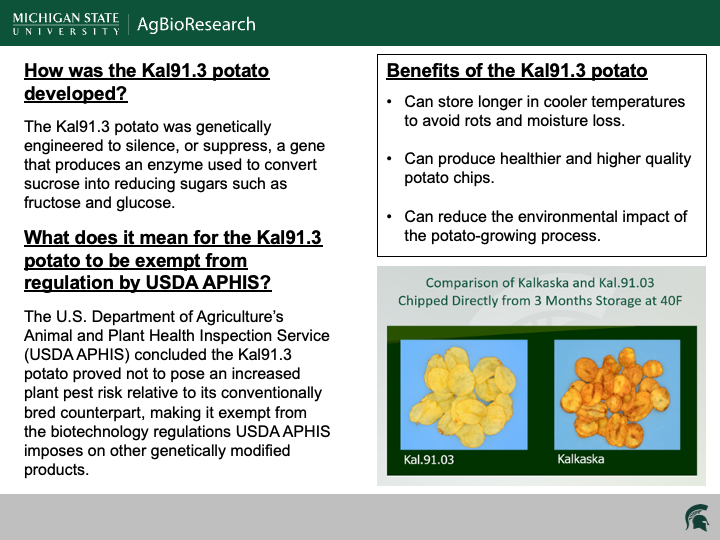MSU potato breeder develops new genetically engineered potato
The Kal91.3 potato can be stored in cool temperatures for long periods of time and produce healthier and higher-quality potato chips.
EAST LANSING, Mich. — A new genetically engineered potato developed by Michigan State University potato breeder Dave Douches has been granted exemption from the biotechnology regulations placed on genetically modified products by the U.S. Department of Agriculture’s Animal and Plant Health Inspection Service (USDA APHIS).
The Kal91.3 potato is bred from an MSU potato variety named Kalkaska. The newly developed potato can be stored in cool temperatures for long periods of time without sucrose, the compound that sugar is typically stored in potatoes as, converting into reducing sugars such as fructose and glucose. Without as many reducing sugars, off-color browning and caramelization can be minimized in the Kal91.3 potato, leading to healthier and higher-quality products, including potato chips.
The Kal91.3 potato can also reduce the environmental impact of the growing process without as many fertilizers and pesticides needed to maintain the potato during storage.

Sucrose is broken down in potatoes by vacuolar acid invertase, an enzyme reactive to the external environment of plants — such as temperature. Roughly 10 years ago, Jiming Jiang, an MSU Foundation Professor in the departments of Horticulture and Plant Biology, published findings on how to silence, or suppress, the gene that produces vacuolar acid invertase in potatoes.
This discovery sparked interest from Douches, a professor in the Department of Plant Soil and Microbial Sciences and director of the MSU Potato Breeding and Genetics Program, to find a way to correct the sugar imbalance that can occur in some of Michigan’s commercial chipping potatoes.
“I’ve always felt as the potato breeder at MSU that using biotechnology as a tool to improve potatoes would be worthwhile,” Douches said. “We have chipping potatoes that work well and do their job, but I wanted to take this gene and find out whether it could improve a potato that was having a problem with its sugars.
“Breeding potatoes is quite challenging because we need so many important traits to line up, but in this case, we just needed one trait to correct the problem. Using this biotech strategy, we succeeded in making a potato that was giving us problems into one that’s now commercially valuable.”
After multiple experiments carried out from 2014-2015, Douches developed an RNA interference (RNAi) construct that silenced vacuolar acid invertase in Kalkaska potatoes.
From 2016-2023, Douches tested the agronomic characteristics of the Kal91.3 potato and found it had a good shape, size and specific gravity — the measurement of starch content compared to water in the potato.
Historically, many farmers have stored chipping potatoes at or around 50 F to avoid vacuolar acid invertase from responding to cooler temperatures and converting sucrose into reducing sugars, but doing so has left potatoes more susceptible to storage rots and moisture loss. The Kal91.3 potato, however, has shown the ability to be stored at 40 F while maintaining its sugar balance.
“There’s a double value to it,” Douches said. “The first is that we stabilize the sugars. The invertase silencing slows down the conversion of sucrose into fructose and glucose, so it stabilizes the potato’s sugar while in storage. It’s settling the potato down from a metabolism point of view. The second is that we benefit from being able to store the potato for longer periods of time at cooler temperatures.”
In January, Douches received notice from USDA APHIS that the Kal91.3 potato proved not to pose an increased plant pest risk relative to its conventionally bred counterpart, thus making it exempt from the biotech regulations USDA APHIS imposes on other genetically modified products. This news meant regulators from USDA APHIS concluded that the Kal91.3 potato could’ve otherwise been developed using traditional breeding techniques.

Research published earlier this year from Jiang and Douches detailed ways of editing the gene discovered to be responsible for cold-induced sweetening, the buildup of fructose and glucose in potatoes while in cold storage. The technology used in that research and in the Kal91.3 potato achieve the same goal of decreasing the accumulation of reducing sugars, but they operate differently, according to Douches.
“In the Kal91.3 potato, we’re putting the gene in a specific orientation in the DNA that tells the potato the gene won’t work as well as it used to — this is what’s called silencing,” Douches said. “In Dr. Jiang’s approach, he found a way to knock out a segment of the promoter, part of the gene that has information on how the gene itself should work. This leads to the same result as silencing.
“His new approach is more of a gene-editing approach, while my current approach is more of genetic-engineering approach.”
The Kal91.3 potato isn’t the first genetically engineered potato with invertase silencing to be exempt from regulation by USDA APHIS. However, it’s the first genetically engineered vegetable developed by a land-grant university to be exempt from regulation, according to the USDA APHIS website.
Douches and his team are now working with Michigan potato industry leaders to evaluate the potential impact the Kal91.3 potato might have on the state’s industry, specifically with chipping.
Michigan is the eighth largest producer of potatoes in the U.S., with 70% used for chips.
Kelly Turner, executive director of the Michigan Potato Industry Commission, said the storage capacity of the Kal91.3 potato has a chance to further stabilize Michigan’s potato industry with a steady supply of potatoes throughout the year, even when fresh harvests aren’t available. She also said the decrease in fructose and glucose found in the potato can lead to a crispier, healthier and tastier chip.
In addition to the benefits that it can create for producers and consumers, the Kal91.3 potato — and others like it — can also benefit the environment and help the industry become more sustainable amidst changing climate patterns, according to Turner.
“Not only does the Kal91.3 potato have a high nutrient content, but it also could be grown by using less fertilizers and pesticides, thus reducing the environmental risk and footprint of the potato-growing process,” Turner said. “Potatoes like Kal91.3 also present opportunities to address climate and weather pattern changes, helping potatoes be more tolerant during periods of drought and other abiotic stresses. This helps to stabilize yields and ensure food security while maintaining environmental diligence under changing climatic conditions.”
Turner said the industry’s partnership with MSU to advance research in areas like the Kal91.3 potato is critical for staying ahead of new developments and providing growers with the novel resources needed to move forward.
“Collaborative research projects between MSU and the potato industry focus on solving practical problems, such as enhancing disease resistance, combatting pests and improving crop yields through genetic modifications,” Turner said. “These joint initiatives ensure that research efforts are aligned with the industry's needs, leading to solutions that are directly applicable to real-world challenges faced by potato growers and processors.”
Michigan State University AgBioResearch scientists discover dynamic solutions for food systems and the environment. More than 300 MSU faculty conduct leading-edge research on a variety of topics, from health and climate to agriculture and natural resources. Originally formed in 1888 as the Michigan Agricultural Experiment Station, MSU AgBioResearch oversees numerous on-campus research facilities, as well as 15 outlying centers throughout Michigan. To learn more, visit agbioresearch.msu.edu.



 Print
Print Email
Email





